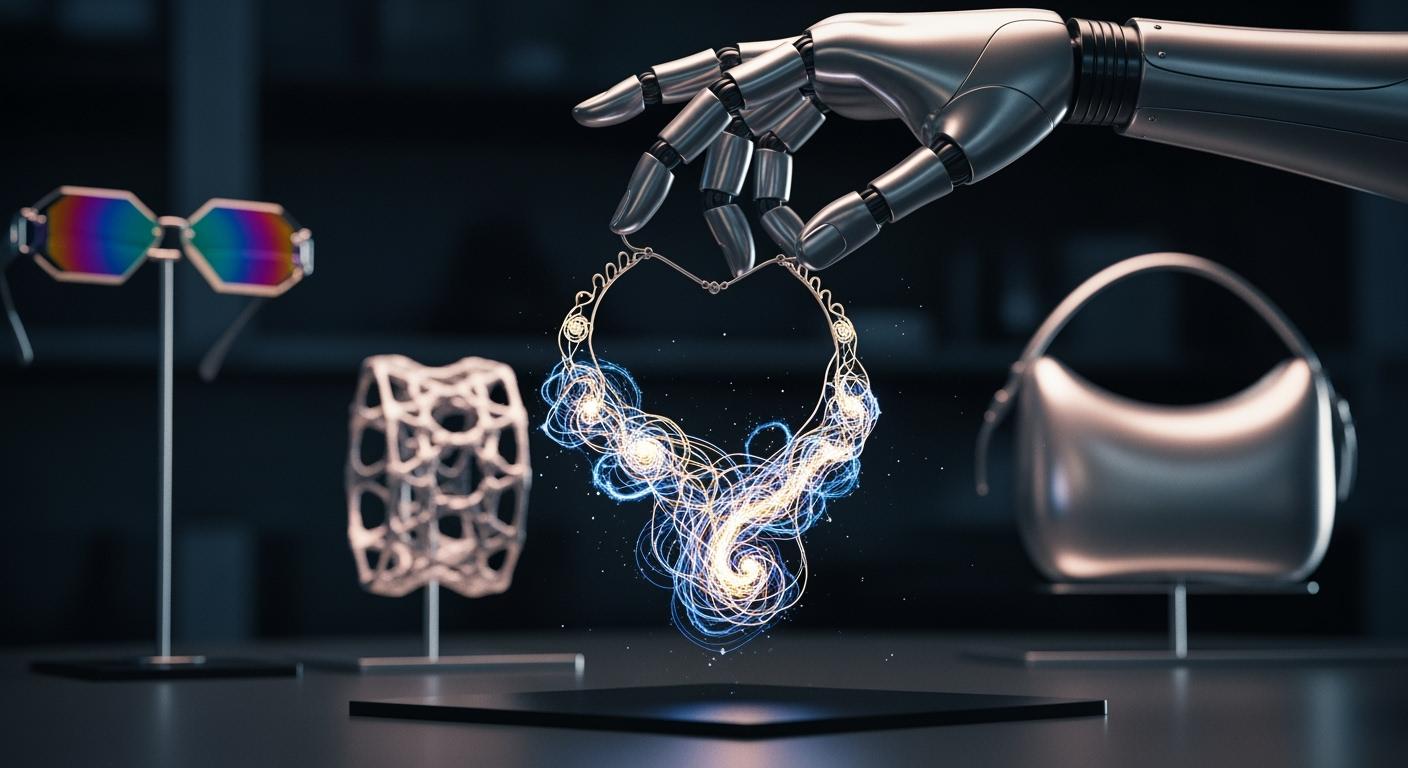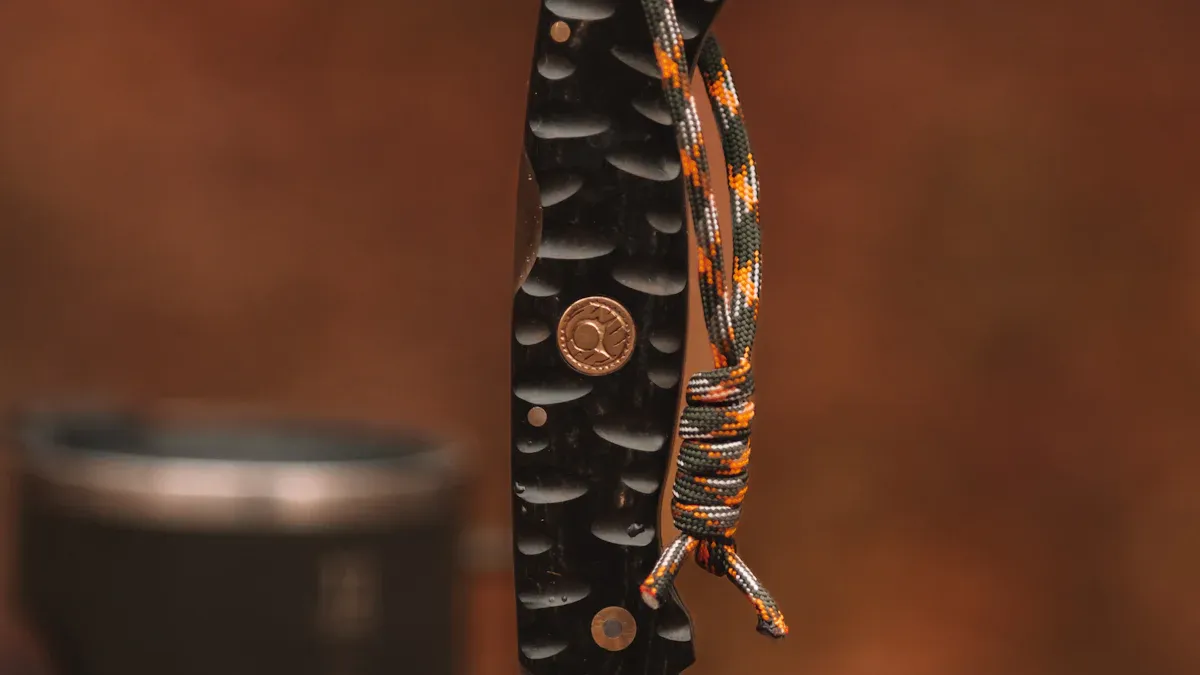
The year 2025 reshapes personal style with five core trends.
- Hyper-Personalization with AI
- Bio-Integrated Forms
- Sustainable AI-Generated Accessories Design
- The Future of Modular Wearable AI
- Functional and Responsive Surfaces
AI evolves the simple wearable from a basic add-on. It becomes a functional and intelligent companion. This AI technology advances how AI wearables are made. AI creates highly personal accessories. AI makes each wearable a smart device. These AI wearables showcase advanced AI. The evolution of wearable AI defines modern technology. This new wave of wearables demonstrates the power of AI.
Hyper-Personalization with AI
Hyper-personalization is transforming the world of accessories. AI is the engine driving this change. It moves beyond simple customization. AI creates accessories that are true extensions of the user. This process uses personal data to craft deeply individualized items. The result is a new generation of ai-generated accessories design.
From User Data to Unique Designs
AI analyzes user data to generate one-of-a-kind designs. This data includes biometric information from fitness trackers and style preferences from user profiles. An AI can use heart rate data for health monitoring. It can also use activity tracking data to inform a design's structure. The AI learns a user's tastes from their purchase history or saved images. This technology powers a new class of ai-enabled devices.
Many tools now use AI for this purpose. These platforms help create unique jewelry and wearable accessories.
- Generative AI programs like Midjourney and Stable Diffusion create realistic jewelry images from text prompts.
- Specialized tools like Gemvision MatrixGold use AI for precise jewelry modeling and customization.
- AI platforms analyze regional trends. They might suggest silver rings to a U.S. customer but gold sets to an Indian customer.
This level of personalization ensures each wearable is unique. It reflects the user's identity, health, and style. The AI makes smartwatches and other wearables more meaningful.
Dynamic and Personal Aesthetics
The future of wearable AI involves accessories that change with you. These AI wearables are not static. Their appearance adapts to real-time data. This creates a dynamic and personal aesthetic. Imagine a wearable that reflects your mood or daily goals. This is becoming possible with new technology and materials.
New 3D-printing methods create color-changing materials. These materials respond to stress or environmental changes. This allows a wearable to provide real-time visual feedback. For example, a smart wrap could change color to indicate swelling, combining health monitoring with visual expression.
This concept extends to many wearables. Smartwatches can already adapt their faces. They show traffic alerts during a commute. They display heart rate zones during a workout. This health tracking offers valuable health insights. Future smartwatches and fitness trackers will take this further. A watch band might change its pattern to celebrate a completed fitness goal. This evolution in wearable AI makes our interaction with technology more intuitive. It connects our digital lives with our physical health and personal style. These health monitors offer continuous tracking and responsive design.
Bio-Integrated and Ergonomic Forms

The next frontier for wearable technology is not just about intelligence but also about integration with the human body. AI is pioneering designs that mimic nature's efficiency. This approach creates accessories that are more ergonomic, comfortable, and visually stunning. The focus shifts from the device to the user's health and comfort. This evolution in ai-generated accessories design makes wearables feel like a natural extension of oneself.
The Role of AI in Mimicking Nature
Generative AI algorithms learn from the world's best designer: nature. These systems analyze vast datasets of natural patterns. They study everything from the veins of a leaf to the structure of a coral reef. The AI learns the underlying principles of these organic forms, such as strength, lightness, and resource efficiency. An AI can then apply these lessons to create novel designs for wearables. This data-driven design process allows an AI to generate complex structures that are both beautiful and highly functional. This technology is key to developing the next generation of wearable AI.
Organic Structures for Comfort
Designs inspired by nature directly improve user comfort and health. The intricate, lattice-like structures created by AI are not just for looks. They offer practical benefits that enhance the wearable experience. These AI wearables are often lighter and more breathable than their traditionally designed counterparts. Better airflow reduces skin irritation, a common issue with devices worn for long periods. This focus on ergonomics is crucial for user health.
For example, an AI can design earbud casings with a porous, bone-like structure. This design allows for better ventilation around the ear, increasing comfort during extended use. The same principle applies to a wearable health monitor, where an AI-designed band can reduce sweat and improve sensor contact with the skin.
This advanced technology helps create ai wearables that adapt to the user. By analyzing data on user movement and biometrics, the wearable AI can suggest or even generate forms that prevent physical strain. This leads to wearables that not only track health but actively contribute to it. A comfortable wearable is a wearable that gets worn, increasing user satisfaction and improving long-term health outcomes.
Sustainable AI-Generated Accessories Design
Sustainability is a major focus in modern product creation. AI offers powerful solutions for a greener future in the accessories market. It transforms how designers use recycled materials. An AI can analyze waste and find new ways to create beautiful, eco-friendly products. This approach reduces landfill waste and gives discarded items a second life. The technology makes sustainability a core part of the design process itself.
Optimizing Upcycled Materials
The journey to a sustainable accessory begins with smart recycling. AI is revolutionizing this first step. It uses advanced technology to sort mixed waste with incredible speed and accuracy. This process ensures that upcycled materials are clean and high-quality enough for reuse in new products. An AI system can identify and separate materials far better than human sorting alone.
This high-tech sorting works in several ways:
- Material Identification: Computer vision and special sensors allow an AI to tell the difference between various plastics, metals, and glass. It can even distinguish food-grade plastics from non-food-grade types.
- Precise Sorting: Robotic arms, guided by the AI, pick and place items into the correct bins. These robots can perform thousands of actions per minute.
- Brand Tracking: An AI can also recognize logos on discarded packaging. This helps track waste back to specific companies, encouraging them to design more recyclable products.
This level of precision creates pure bales of recycled material. These high-quality materials are then ready for designers to use.
Creating Aesthetics from Waste
Once materials are sorted, AI helps turn them into desirable accessories. Generative AI tools can create unique aesthetics directly from waste. An AI analyzes the properties of the available upcycled materials, such as their color, texture, and shape. It then proposes new designs that highlight the unique character of these materials. This creates a new vision for ai-generated accessories design.
For example, an AI might look at a collection of blue and green plastic shards. It could then generate a design for a bracelet with a beautiful mosaic pattern. The AI can also run hundreds of virtual tests to create durable designs that use the least amount of material possible.
This process finds beauty in imperfection. It turns what was once trash into a statement piece. The final accessory not only looks good but also tells a story of sustainability and smart design. The AI empowers designers to see waste not as a problem, but as an opportunity for innovation.
The Future of Modular Wearable AI
The future of personal accessories is not about replacement but evolution. Modular design allows a single wearable to change over time. AI is the architect of this new approach. An AI can create entire systems of interchangeable parts. This technology transforms a static item into a dynamic platform. This shift makes wearables more sustainable and personal.
Generative Systems for Interchangeable Parts
AI can generate a complete ecosystem of compatible parts for a wearable. This includes everything from clasps and links to functional charms. The AI ensures every piece fits and works together perfectly. This process creates a foundation for truly customizable ai wearables. Several powerful AI platforms already exist for modular design in other fields.
- Zenerate creates site-specific designs and optimizes layouts.
- Kope AI offers a marketplace for prefab components.
- Finch3D automates complex operations for modular workflows.
This same technology can be applied to ai-generated accessories design. Some companies already use an 'Intelligent parts assistance' service. This AI-driven service recommends new or replacement parts for devices. It helps engineering teams find what they need quickly. This shows how an AI can manage a complex library of parts for any wearable.
An Evolving 'Kit of Parts'
A modular 'kit of parts' approach makes a wearable last longer. Users do not need to buy a whole new device for an upgrade. They can simply swap out a module. This reduces consumer waste and the need for frequent replacements. This method allows a single wearable accessory to evolve with a user's style or needs. The core wearable remains, but its function and look can change.
This evolving system means a wearable can gain new abilities over time. New functional modules can be released and added easily. Future wearable AI modules could include advanced AI-biosensors for health diagnostics or flexible sensors that monitor vital signs like heart rate and blood oxygen.
This concept extends the life of wearables. It also makes our interaction with wearable AI more adaptive. The AI helps create a system where your favorite wearable gets better with age. These ai wearables become long-term companions instead of disposable gadgets.
Functional and Responsive Surfaces

The next evolution in wearable design moves beyond static forms. Surfaces themselves are becoming interactive and intelligent. An AI is the key to designing these dynamic surfaces. It allows a wearable to communicate information without a screen. This technology transforms a simple accessory into a responsive partner. The AI helps create a more natural interaction between the user and their device.
Designing for Dynamic Interaction
An AI designs surfaces that physically react to user data or the environment. This creates a new level of dynamic interaction. The AI analyzes when and how a surface should change. It then applies this logic to new smart materials. This process makes advanced ai wearables possible. Several new materials are enabling this shift.
- Flexible Electronic Circuits: These soft circuits can be stretched and washed. They allow for haptic feedback in a comfortable wearable.
- Heat-Activated Materials: New fibers made from recycled plastic can change color and shape with heat or electricity.
- Temperature-Reactive Fabrics: Special fabrics can change their shape when heated. A woven pattern can turn into a cone and then back again.
- Programmable Fibers: A low-cost fiber can contract or expand with temperature changes. This allows for digital control over a fabric's form.
An AI can use these materials to design wearables that adapt in real-time. This makes the wearable a true extension of the user.
Beyond the Screen Aesthetics
This new design approach offers communication beyond a simple screen. Information is felt, not just seen. This creates a more private and intuitive experience for the user. The wearable ai can send alerts through a gentle change in texture or shape. This is a major step forward for wearable technology.
For example, an AI can design an adaptive sports bra using programmable fibers. The wearable ai would tighten the fabric for support during a run. It would then loosen the fabric during a cool-down. This provides function without the user ever looking at a screen.
This method creates a new language for ai wearables. A change in the surface of a wearable can signal stress levels, celebrate a goal, or provide navigation cues. The AI designs these subtle changes to make our wearables more helpful and seamlessly integrated into our lives.
The future of accessories is intelligent and adaptive. Five key trends shape this evolution: Hyper-Personalization, Bio-Integration, Sustainability, Modularity, and Responsive Surfaces. The synergy between AI and each wearable makes our interaction with technology more seamless. This AI technology helps each wearable become a proactive assistant. The wearable AI anticipates user needs.
Human designers will guide AI to create the next generation of intelligent wearable AI. This collaboration will define the future of the wearable.
FAQ
How does AI help accessory designers?
AI acts as a powerful tool for designers. It analyzes data to generate new ideas. The AI can create complex, nature-inspired forms or optimize designs for upcycled materials. This process helps designers innovate faster and create highly personalized accessories for users.
Is my personal health data safe with AI wearables?
Companies prioritize user privacy. They use strong security measures to protect personal information, including health data. Users typically have control over what data they share. This ensures that sensitive health information remains secure while enabling personalized features.
What is AI's role in health monitoring?
AI enhances health monitoring in wearables. It analyzes biometric data to provide deep insights into a user's health. This technology powers continuous monitoring of vital signs. The goal is to create accessories that proactively support a user's overall health and well-being.
Example: An AI can track sleep patterns or heart rate trends. It then offers personalized suggestions to improve the user's health. This makes monitoring more than just data collection.
Can AI-generated accessories really be sustainable?
Yes, AI significantly boosts sustainability. It helps sort waste materials with high accuracy. AI also designs products that use fewer resources or repurpose waste into new, beautiful items. This technology makes the creation of eco-friendly accessories more efficient and innovative.
See Also
Revolutionizing 2025 Fashion Supply Chains with Advanced AI Sensor Technology
Sustainable Fashion AI Innovations: Paving the Way for a Greener Future
Optimizing 2025 Fashion Retail with Dynamic AI Safety Stock Solutions
AI's Role in Managing Rapid Viral Trends within Fast Fashion
Intelligent Fashion AI: Streamlining Product Returns for Enhanced Efficiency